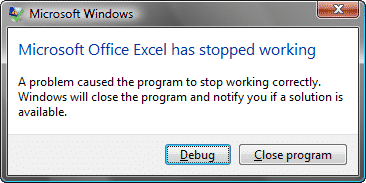However, the use of Excel often brings some problems with it, and when it comes to quality assurance, Excel files are very vulnerable! Here are six examples of the way that using Excel and manual reporting can harm your business:

1. Only a few people have the know-how
Usually only 1–2 people in a company have good Excel skills. In general, I think it’s fair to say that most people do not like Excel at all. Because of this, there are generally only a couple of people in an organization that truly master this tool. When they are absent for a longer time, it is common for reports to not be updated. This, in turn, means that it might not be possible to complete some reports for up to a month while these people are absent. If there is no data available for a month, it often means that not much is getting done, either. You cannot know what you cannot know.
2. Changes in source data
Typically, data from other software is entered into Excel and combined into a single view by using formulas and “coding”. It is quite common for the source software to be updated. Software has the tendency to keep on developing. As a result of new updates, the source data may change so that the existing formulas and “code” need to be replaced. This could easily take 1–3 workdays. All of this means lost work hours for supervisors and experts – hours that could have been spent on e.g. coaching.
3. Faulty formulas
Mistakes in a formula are usually easy to fix if they are noticed. Often they are easy to notice, due to “#DIV/0!” or another more or less familiar warning appearing in a cell. But sometimes you do not get an error message, just an incorrect figure as the result of a flawed formula. If the formulas are not checked, it is possible that an incorrect figure is monitored. One incorrect figure could lead to a whole lot of actions that should not be taken at all.
4. Changing goals
Generally, the goal for reporting is to be able to compare the report with the goals in a simple way. Have we reached the goal or not? It is easy to create conditional formatting in Excel or to write down the goals in the comments or another application. But what if the goals change? Once again, this means a lot of manual changes that might take hours or days to implement.
5. No mobile features
Surely you can use Excel on a mobile device! Yes, but it is far from a pleasant experience. For example, filling out evaluation forms in Excel on a mobile device is far from easy, not to mention reporting.
6. High costs
Using Excel might, at first, sound like the cheapest possible quality assurance solution. However, that is definitely not the case! The costs that result from using Excel are high, because these tasks are mainly handled by supervisors and/or experts. Let’s say there are 200 agents in your customer service. The goal is to perform 2 evaluations / agent / month. In addition, you want to have one 30-minute coaching session with each agent every month. The additional work you need to do when using Excel to fill in evaluation and coaching forms, sending them to the agents manually and creating reports takes a little over 3000 work hours annually. The price is 30 € per hour, which is what the organization pays for the work of supervisors and experts. This means that the minimum cost of using Excel for these tasks is a little over 90,000 €.
QualityDesk as a solution
So we can conclude that there are plenty of risks, some of them quite big. Using Excel takes a lot of time, accuracy and patience. For some business areas, Excel is extremely useful and practical, but quality assurance is not one of those processes.
With QualityDesk, you can handle the entire quality assurance process with one software solution. Automatic reporting gives you and your employees real-time visual representations of the data. This means that you know exactly what is happening at the customer interface and what type of coaching your employees need. In addition, you save time and money, as explained in example 6. In the example scenario, the savings would be more than 37,000 € per year.
Our software offers a coaching form that you can use to keep track of coaching sessions. All agreed actions and goals are easy to track, so you will not lose sight of them.
Contact me by clicking this link, or by calling +358505737601
Together, we can go over your customer service’s current situation and calculate how much you could save by switching to QualityDesk!




